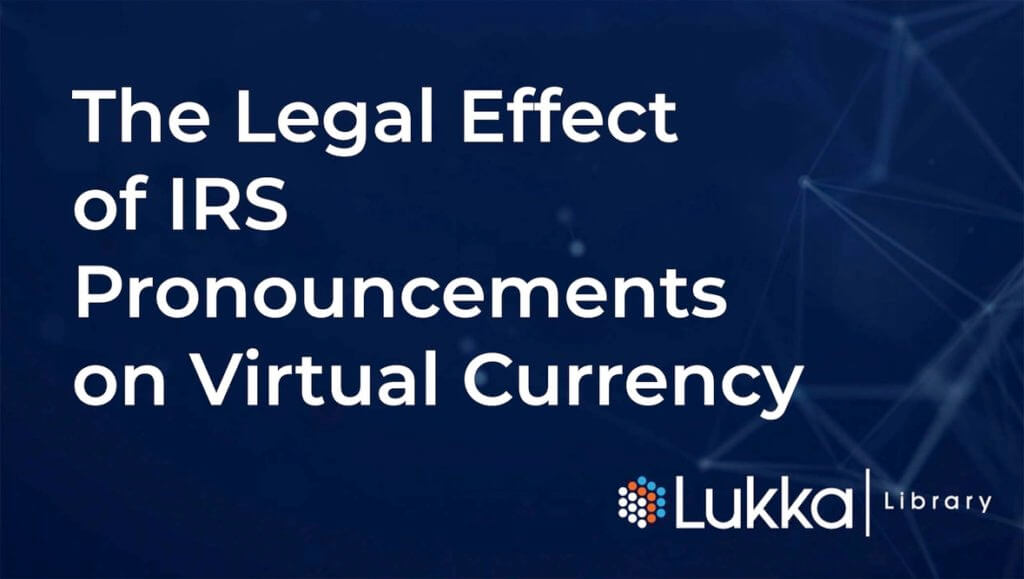
The discussion in this document reflects legal principles as of January 31, 2020.
Author: Andrea S. Kramer*
Taxpayers who hold virtual currency have limited guidance as to the taxation of their activities. As of the date of this Memorandum, government advice is limited to IRS Notice 2014-21, Revenue Ruling 2019-24, and 2019 Frequently Asked Questions.1 No specific Code sections or Treasury regulations address virtual currency. This means that taxpayers can follow the limited guidance about virtual currency available if they agree with the IRS’s positions. But what if they don’t agree? Can taxpayers choose to take tax positions that are contrary to IRS pronouncements? The answer is yes, but there can be consequences to their decisions, which are discussed in this Memorandum.
This Memorandum explores the legal effect of the Notice, Ruling, and FAQs about virtual currency, explaining the sort of deference that courts tend to put on different types of IRS pronouncements.
IRS Interpretive Role
The IRS’s role “in administering the tax laws enacted by the Congress” is to translate them into detailed regulations, rules, and procedures. To do this, the IRS’s Office of Chief Counsel releases various “documents and publications that provide guidance to taxpayers.”2 Rulings, Notices, and FAQs are among the types of publications and information that the IRS issues.
The IRS is a bureau of the Treasury Department. As such, the IRS is a member of the Executive Branch.3 The Treasury cannot unilaterally make binding tax law unless the Congress has specifically delegated rulemaking authority to it. Therefore, short of working with the Treasury to enact Treasury regulations, the IRS only has the authority to provide taxpayers with its views on the proper interpretations of tax laws and to challenge—on audit (subject to judicial review)—what it views as abusive or incorrect tax positions that taxpayers take on their tax returns. If a taxpayer challenges the IRS’s position in court, the IRS must convince the court that its tax position is the correct one for the court to accept.
Judicial Deference Given to Rulings, Notices, and FAQs
As a rough rule of thumb, federal courts tend to give Treasury and IRS pronouncements different levels of deference under various doctrines named after Supreme Court cases. In general, there are three levels of deference that courts apply to Treasury regulations and IRS guidance. The highest deference is given to Treasury regulations that include a reasonable or permissible interpretation of an ambiguous statute. This is referred to as Chevron deference.4 The next level down in deference is Skidmore deference which is for administrative pronouncements other than Treasury regulations. The Skidmore doctrine directs courts to take into account the IRS’s experience and expertise. Under Skidmore deference, the courts retain their ability to ignore the IRS’s views—even if reasonable—if the courts believe a better interpretation of tax law is to the contrary.5
The last level of deference is referred to as Aver or Seminole Rock deference. This deference is given to agency interpretations of their own regulations that should control unless the interpretations are “plainly erroneous or inconsistent with the regulation.”6
Under these different standards for deference, courts give lower deference to IRS pronouncements than they do to Treasury regulations, only according such pronouncements with the weight that is warranted given the persuasiveness of the IRS’s positions.7 And, the recent Supreme Court decision is Kisor v. Wilkie8 is likely to have an impact on the deference courts give to ambiguous regulations.
This brings us back to the government guidance that is currently available with respect to virtual currency. The remainder of this Memorandum applies these doctrines to the Revenue Ruling, the Notice, and FAQs.
Revenue Rulings
A revenue ruling is published in the Internal Revenue Bulletin by the IRS National Office as an official interpretation of the Code, related statutes, tax treaties, and Treasury regulations. A revenue ruling sets out the IRS’s conclusions on how the law is applied to a specific set of facts. A revenue ruling is issued in reply to specific taxpayer requests for guidance and to address factual situations that the IRS wants to speak to. Taxpayers can rely on rulings as authoritative and as precedent because the IRS (but not taxpayers) is bound by them.9 Although courts need not view rulings as being as authoritative as Treasury Regulations, rulings can be treated as more persuasive or authoritative than notices because rulings are the result of more deliberation, come from the National Office, and apply the IRS’s interpretation of the law to a specific set of facts. Although rulings do not bind a court, taxpayers whose circumstances are substantially the same as those described in a ruling can rely on it without fear of penalty. Taxpayers with different circumstances are free to ignore the ruling. And courts can reject the positions taken in a ruling.
IRS Notices
A notice provides taxpayers with guidance on matters of general importance,10 often announcing enactment of a regulation or changes to technical tax rules.
The IRS tends to use notices to get its views out quickly about rapidly evolving areas of the tax law. The IRS might also issue a notice prior to the time when the Treasury issues regulations in an effort to shape taxpayer reporting during the regulatory formation process. Although notices are not controlling legal authority, taxpayers can rely on them as authoritative and as precedent because the IRS is bound by its notices.11 Notices do not bind a court; they do not have the “full force of law” as do the Code and Treasury regulations.12 And, notices have less precedential value than a ruling.13 Indeed, although there is very little case law with respect to the deference courts give to notices, the limited authority makes it clear that notices can be accorded less deference than rulings.14
Notices and revenue rulings are, thus, akin to announcements of the IRS’s litigating position. They are only as strong as the legal authorities cited, the persuasiveness of the IRS’s interpretations, and the relevance of the particular facts. Moreover, notices are not predictors of litigation success.15 To have the force and effect of binding law, the Treasury must issue the same content in a regulation. This makes sense because notices and revenue rulings do not involve the same deliberative process, public comment, and upper level Treasury review that is involved in issuing Treasury regulations.
Thus, although notices are not controlling legal authorities, they can have some higher legal significance than notices because they represent the IRS’s opinion as to how tax laws should apply to subject transactions.
FAQs
FAQs are issued by the IRS as sources of general information. FAQs are not authoritative and do not serve as precedent in tax disputes.16 It is likely that courts would provide even less deference to FAQs than notices or revenue rulings.
Whether dealing with rulings, notices, or FAQs, taxpayers need to determine whether they believe the government’s positions are correct. Taxpayers who disagree with the IRS’s positions should discuss their concerns with their tax advisors to address the consequences to them of taking positions contrary to IRS pronouncements.
* This material is for general information purposes only and should not be construed as legal advice or any other advice on any specific facts or circumstances. No one should act or refrain from acting based upon any information herein without seeking professional legal advice. McDermott Will & Emery makes no warranties, representations, or claims of any kind concerning the content herein. McDermott and Andrea S. Kramer expressly disclaim all liability to any person in respect of the consequences of anything done or not done in reliance upon the use of contents included herein. For a complete list of McDermott entities, visit mwe.com/legalnotices.
©2020 McDermott Will & Emery. All rights reserved. Any use of these materials including reproduction, modification, distribution or republication, except as part of the Lukka Library is strictly prohibited without the prior written consent of McDermott. This material may be considered attorney advertising. Prior results do not guarantee a similar outcome.
1 Notice 2014-21, 2014-16 I.R.B. 938, Rev. Rul. 2019-24, ______ I.R.B. ____; Frequently Asked Questions on Virtual Currency Transactions, IR-2019-167, https://www.irs.gov/individuals/international-taxpayers/frequently asked-questions-on-virtual
2 https://www.irs.giv/newsroom/understanding-irs-guidance-a-brief-primer
3 In the U.S. legal system, the IRS is a bureau of the Treasury Department, both of which are part of the Executive Branch and help the U.S. President administer federal tax laws. The U.S. Constitution grants the U.S. Congress the power to legislate tax laws. Given the complexity of the U.S. tax system, however, Congress often delegates some of that rulemaking authority to the Treasury, which in turn issues Treasury regulations that have the force of law. The IRS issues many types of pronouncements of varying legal weight and precedential value. Thus, when judging the legal weight of any IRS action or pronouncement, it is necessary to consider whether the Treasury is acting pursuant to a Congressional delegation of power to make binding tax rules or acting pursuant to general Executive Branch powers to enforce the law.
4 Chevron, 467 U.S. 837 (1984).
5 323 U.S. 134 (1944). IRS pronouncements do not received the higher level of deference provided under Chevron deference, which typically applies to Treasury regulations.
6 Aver, 519 U.S. 452 (1997) Seminole Rock, 325 U.S. 410 (1945).
7 U.S. v. Mead Corporation, 533 U.S. 218 (2001).
8 Kisor v. Wilkie, No. 18-15, 588 U.S. ___ (2019).
9 GAO, Highlights of GAO–16-720, “Treasury and OMB Need to Reevaluate Long-Standing Exemptions of Tax Regulations and Guidance,” September 2016, https://www.gao.gov/assets/680/679517.pdf.
10 The Internal Revenue Bulletin describes itself as “the authoritative instrument of the Commissioner of Internal Revenue for announcing official rulings and procedures of the Internal Revenue Service and for publishing … items of general interest.” 1991-1 C.B. iii.
11 GAO, “Highlights.”
12 See Cantwell v. Deutsche Bank Sec., Inc., No. 3:05-CV-1378-D, 2005 U.S. Dist. LEXIS 20597, at *19 n.7 (N.D. Tex. Sept. 21, 2005) noting that “IRS Notices are not binding on this or any court”. See also Guilzon v. Commissioner, 985 F.2d 819, 822 (5th Cir. 1993) (finding that Notice are not authoritative, and the Court should only look to them for guidance when a statute and its legislative history are “completely ambiguous”) (emphasis in original).
13 See Samonds v. Comm’r, 66 T.C.M. (CCH) 235 (1993) (noting that an IRS Notice “is an administrative pronouncement which like a revenue ruling or revenue procedure does not constitute authority for deciding a case in this Court”).
14 See, e.g. Stubbs Overbeck & Associates v. United States, 445 F.2d 1142, 1146-47 (5th Cir. 1971); Neuhoff v. Commissioner, 75 T.C. 36, 46 (1980). “[A]lthough they are entitled to some consideration, they do not control when contrary to statute or the expressed intention of Congress.” True Oil Co. v. C.I.R., 170 F.3d 1294 (10th Cir. 1999) citing Storm Plastics, Inc. v. United States, 770 F.2d 148, 154 (10th Cir. 1985).
15 See, e.g., IES Industries, Inc. v. United States, 253 F.3d 350 (8th Cir. 2001) rev’g (in relevant part) 1999 U.S. Dist. LEXIS 22610 (N.D. Iowa 1999) and Compaq Computer Corp. v. Commissioner, 277 F.3d 778 (5th Cir. 2001) rev’g 113 T.C. 214 (1999). In these cases the respective Appeals Courts reversed lower court decisions that adopted the IRS position in Notice 98-5 describing so-called “abusive foreign tax credit tax shelters.” 15 See, e.g., IES Industries, Inc. v. United States, 253 F.3d 350 (8th Cir. 2001) rev’g (in relevant part) 1999 U.S. Dist. LEXIS 22610 (N.D. Iowa 1999) and Compaq Computer Corp. v. Commissioner, 277 F.3d 778 (5th Cir. 2001) rev’g 113 T.C. 214 (1999). In these cases the respective Appeals Courts reversed lower court decisions that adopted the IRS position in Notice 98-5 describing so-called “abusive foreign tax credit tax shelters.”
16 GAO, “Highlights.”



